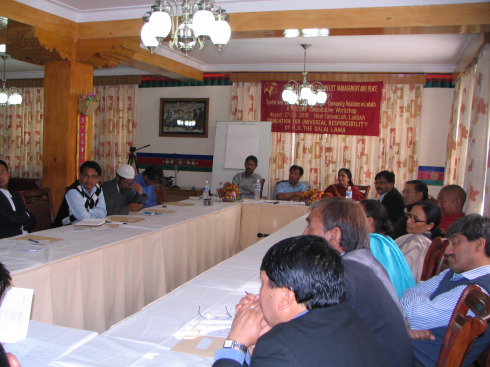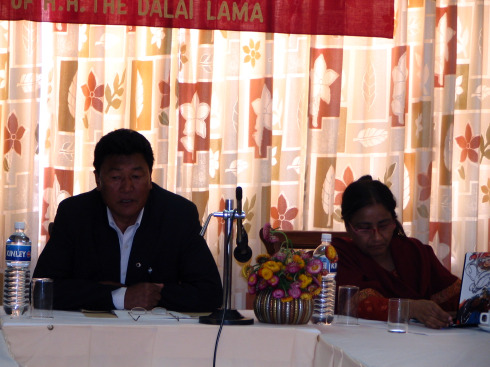On August 6, 2010 the Himalayan town of Leh in the Ladakh region of Jammu and Kashmir on the Indian side was struck by torrential rains which completely destroyed some of its roads, bridges, hospitals and communication lines. Hundred of people were killed and many are still missing. The tragedy shocked the nation and the Jammu and Kashmir and Central governments ensured that relief and rehabilitation, including the evacuation of international and domestic tourists, was immediately enacted.
Women in Security, Conflict Management and Peace (Wiscomp; a Delhi based initiative of the Foundation for Universal Responsibility) had an inter-community dialogue planned when the tragedy struck. With civil society and the administration focused on the completion of relief and rehabilitation work before the onset of winter (when the temperature in Ladakh can drop to -30 degrees), it was extremely challenging to go ahead with the proposed dialogue. Many however welcomed the decision to continue with the event as planned: “We are so glad that you have decided to come and hold this workshop. This is the time when all communities should come together for rehabilitation and peace in Ladakh” said Professor Jamyiang from Central Institute for Buddhist Studies.
Ladakh, which lies to the north east of Kashmir Valley, from where it is administratively controlled. There are two districts in Leh; one predominantly Buddhist, and one predominantly Shiite Muslim. There is also a very small Christian community in Leh. Ethnically and culturally different from other parts of Kashmir, many in Ladakh wish to separate and form a Union Territory directly administered by the Union of India. This is not, however, the simple solution it would seem, and there are many disagreements within Ladakh over political power and representation. These tensions add to the internal religious conflicts in Ladakh, which are in turn linked to the resolution of the Kashmir conflict.
The Shiite Muslims from Kargil do not advocate separation from Kashmiri Sunni Muslim population as the Zojila Pass, their life line that links them to the Kashmir Valley. They wish to include the Gilgit-Balistant people from Pakistan-administered Kashmir and aspire for a Greater Ladakh region, although it is not clear under whose control. They are not keen on the Union Territory status that is being demanded by Buddhists in the region as they fear Buddhist domination in political, administrative and economic sectors.
Kargili’s complain that while the Muzafarabad–Srinagar Road and the plight of divided Kashmiri families have captured the media headlines and the attention of the international community, the largest number of divided families live across Kargil and Gilgit. Those in Kargil have therefore been demanding the Kargil-Skardu road to be reopened so that the divided families can meet. The Kashmir and Central union is however, yet to respond to this demand.
These complexities and the recent history of communal violence in Ladakh demonstrate that the terrain of peacebuilding in Jammu and Kashmir needs to be extended to Ladakh and the Jammu Division which also have a critical stake in the Kashmir conflict and its resolution.
Inter-community Dialogue
Since 2000 WISCOMP has been engaging with the civil society in Kashmir, Jammu and Ladakh to build constituencies of peace. A major focus in their peacebuilding efforts has been the use of dialogue as a tool for bringing key stakeholders together to share their perspectives, aspirations and political goals so as to create a common ground identifying possibilities, and issues which connect people so as to design a collective future.
The initiative in Leh, Ladakh was also designed with the purpose of bringing together Buddhist and Muslim communities from different parts of Ladakh to discuss inter-community relations for peacebuilding in the region. The flashfloods provided a new context for the existing and past inter-community relations and future courses of action. Does disaster open new opportunities for interdependence and co-existence? This is a question which needs also to be addressed in the larger context of India and Pakistan, particularly given that the latter is witnessing the worst natural disaster in their history.
The two day dialogue ‘Symbol and Substance: Exploring Inter-community Relations in Ladakh’ brought together community, religious, and youth leaders; women groups; the media; teachers and professors; advocates; civil servants; development practitioners; and business associates. The purpose was both to understand the dynamics of Buddhist –Muslim relations, and to rekindle the spirit of co-existence. As Ashraf Ali Barchapa, President of Anjuman–e-Imamia, a Shia religious body, remarked “We wish the same future for rest of the people in Jammu and Kashmir as we would wish for ourselves.”
The dialogue covered a number of important issues including the political future of Ladakh, sustainable development, and disaster management. It also generated an interactive discourse on the significance of cultural identity and the way religion is being used in Ladakh for the achievement of political goals. “In fact religious groups sponsor political parties and political parties rake up communal action of an individual to politicize communities along religious lines”- Nasir Shabani, a government school teacher from Kargil.
The participants acknowledged the role of His Holiness Dalai Lama in influencing Buddhists in showing compassion and tolerance towards Muslims. The Buddhists however felt that reconciliation with Muslims would only happen when the Muslims of Kargil allowed the construction of Buddhist Gompa in Kargil. Local Muslims are resisting this, claiming that there are no Buddhist residents in the city of Kargil. Whilst the Buddhists argue that many Buddhists work in Kargil offices and live as tenets.
Overall there were many trust issues between the Buddhists and Muslim parties to this discussion which it will take some time to overcome.
Conclusion
With every sub-region in Kashmir struggling with their own regional aspirations and political goals, and community relations affected by social, political, and religious tensions, peacebuilding initiatives in Kashmir need to work at several levels to open spaces for an inclusive dialogue. WISCOMP’s intervention, at a time when communities in Ladakh are fragmented along religious and political lines, brought to focus the way disaster can be linked to inter-community relationships. While disaster brings together people and communities for relief and rehabilitation, it can also divide the same people and communities if relief is not distributed in a transparent and impartial manner. In such times deep prejudices can surface to exacerbate conflicts. Efforts such as this to bring all key stakeholders across regions, sub regions, communities and political spectrum in a dialogue is perhaps the only way forward for peace in the region.
[linked page_id="6092"]











